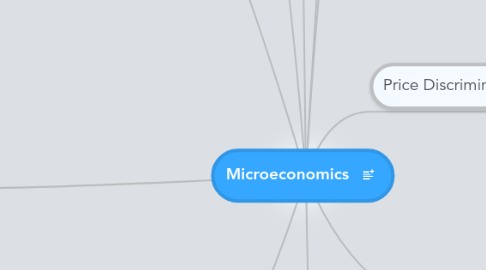
1. Contestable Markets
1.1. Perfect competition/oligopoly/monopoly - structure
1.2. Price/Output/non-price decisions - conduct
1.3. Efficiency (static and dynamic) - Performance
1.4. A market is perfectly contestable when the costs of entry and exit by potential rivals are zero.
1.5. Recent increasing contestability of markets is due to: 1) Entrepreneurial zeal 2) De-regulation of markets 3) Competition Policy 4) The European Single Market 5) Technological Change
2. Profit Maximisation
2.1. Normal profit
2.1.1. The level of profit that is required to keep all the factors of production in their present use
2.1.2. New node
2.2. Supernormal profit
2.2.1. The level of profit above normal profit
2.3. Maximizing profit
2.3.1. MC = MR
2.4. Role of profit
2.4.1. Incentive to innovate
2.4.2. Incentive to attract new firms to market
2.4.3. Re investing into R&D
3. Efficiency
3.1. Allocative efficiency
3.1.1. Price is equal to Marginal cost, no one can be made better off without making some other agent at least worse off. When goods are produced in line with consumer preferences.
3.2. Productive efficiency
3.2.1. When the equilibrium output is supplied at minimum average cost. (Lowest point on the average cost curve)
3.3. Dynamic efficiency
3.3.1. Product or process, occurs over time. Product focuses on those improvements that lead to goods and services which perform better or are of higher quality. Process innovation looks at progress which leads to better methods of production and hence reduces a firm's average costs.
3.4. X inefficiency
3.4.1. When a firm is not producing on the average cost curve, owing perhaps to 'organizational slack' (usually associated with monopoly)
3.5. Consumer surplus - The difference between the price the consumer is prepared to pay and the market price
3.6. Producer surplus - The difference between the price at which the producer is prepared to supply and the market price
4. Monopoly
4.1. Benefits from a monopoly
4.1.1. Economies of scale.
4.1.2. Monopoly profits used in R&D and Dynamic efficiency.
4.1.3. Scope to be internationally competitive
4.2. What is a monopoly? When a firm owns more than 25% share of a market
4.3. Disadvantages of a monopoly
4.3.1. Lack of competition in the market may reduce quality of service.
4.3.2. Monopolies can use their market power to raise prices.
4.3.3. Monopolies can earn abnormal supernormal profits at the expense of efficiency and the welfare of consumers and society.
4.3.4. productive and/or X inefficiencies can occur as the firm is not making optimum use of scarce resources.
4.3.5. Allocative inefficiency (underconsumption)
4.4. Oligopoly - A market dominated by a few producers, each of which as a degree of control in the market so the industry is likely to have a high level of market concentration.
5. Oligopoly
5.1. A market dominated by a few producers each which a degree of control in the market
5.2. characteristics: 1) Interdependence and uncertainty 2) Entry barriers 3) Product branding 4) Non-price competition
5.3. The importance of non-price competition: 1) Better quality of service 2) Longer opening hours 3) Discounts on product upgrades 4) advertising and loyalty cards
5.4. There is an element of tacit collusion (price leadership)
5.5. game theory; strategic measures to corner opposing firms into doing what the firm wants
6. Price Discrimination
6.1. This occurs when a firm charges a different price to different groups of consumers for an identical good or service for reasons other than cost.
6.2. Conditions required for price discrimination to work: 1) Differences in price elasticity of demand between markets, to profit maximise, the firm will seek to set marginal revenue = to marginal cost in each of the different markets (segments). 2) Barriers to prevent consumers switching from one supplier to another, therefore the firm must have methods to prevent 'market seepage' or 'consumer switching'.
6.3. 1st degree price discrimination: Haggling
6.4. 2nd degree price discrimination: Batch, bulk buying
6.5. 3rd degree price discrimination: Time, age (e.g students charged different prices to senior citizens)
7. Perfect Competition
7.1. Basic assumptions required for perfect competition to exist in a market
7.1.1. No barriers to entry
7.1.2. Identical Product
7.1.3. Lots of buyers and sellers
7.1.4. No externalities
7.1.5. New node
7.1.6. Perfect information
7.2. High levels of economic efficiency
7.2.1. Allocative efficiency
7.2.2. Productive efficiency
7.2.3. Dynamic efficiency
7.3. Sunk costs
7.3.1. A cost that cannot be recovered (e.g. advertising)
7.4. Benefits of competition
7.4.1. Lower prices because of competing firms
7.4.2. Low barriers to entry
7.4.3. Lower total profits, less loss of welfare
7.4.4. Greater entrepreneurial activity
7.4.5. Economic efficiency
8. Concentrated Markets
8.1. Concentration ratio
8.1.1. The value of output from the 5 largest firms/value of output for the industry
8.2. Growth
8.2.1. Internal - Profits that are generated from the firm are retained and utilized to finance the expansion and growth of the firm; fixed and variable factors are production are increased
8.2.2. External
8.2.2.1. Horizontal integration - two firms at the same stage in the supply chain and production process merge.
8.2.2.2. Lateral integration - two companies that are related but not identical merge
8.2.2.3. Vertical integration - Firms within the same industry but at different levels on the supply chain merge
8.2.2.3.1. Backward
8.2.2.3.2. New node
8.2.2.4. Conglomerate - a merger between firms in unrelated business'
8.3. Outsourcing
8.3.1. Technological change - making it easier for firms to outsource both service and manufacturing operations to sub contractors in other countries.
8.3.2. Increased competition - seeking low inflation environments
8.3.3. pressure from financial markets - for businesses to improve their profitability
9. Costs and revenues
9.1. Law of diminishing returns
9.1.1. The decrease in marginal output as one factor of production is increased, while all others remain constant. (fixed factors become overloaded)
